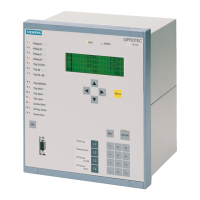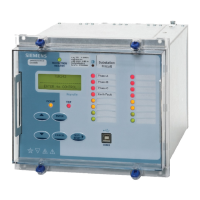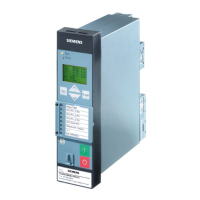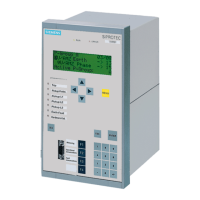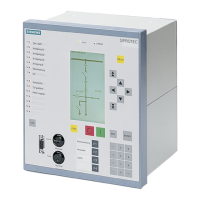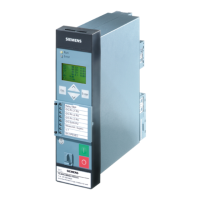7UT51 v3
Thermal Overload Protection (49-1, 49-2)
9
PRIM-2330C 109
Example:
If the short-time overload capacity is stated
for a duration of 1 s, then that short-term
current is inserted into the above formula.
Note:
The result becomes more inaccurate the
longer the stated duration of the current
becomes.
The single-body thermal body model used by the relay
is appropriate for small continuous overloads (up to
approximately 1.2 times the rated current). For larger
continuous overloads, it is sufficient to set a slightly
shorter time constant which considers the faster
warm-up of the winding as compared to the iron.
9.3.3 Warning Alarm Levels
The element can generate a warning-alarm event prior
to the pickup event. The alarm event can be
configured to trip and output contacts to take
corrective actions (load shedding, activation of cooling
equipment, etc.).
Two types of warning exist; one based on temperature
rise, and the other based directly on the overload
current.
The warning based on temperature rise occurs when
the calculated temperature rise reaches a specified
percentage of the trip value. Of course, the warning
level should be less than 100% of the trip-level
temperature rise (Q
trip
), and higher than the
temperature at the allowed maximum continuous
overload current (Q
cont
), which can be calculated from
the k factor:
(9.5)
For example, if k is 1.1, then 1/k
2
is 83%, so Q
warn
should be more than 83% (the allowed continuous
overload current) and less than 100% (the trip-level
temperature rise).
The warning based on the overload current occurs
when the measured current reaches a specified
multiple of the rated current:
9.3.4 Temperature Rise
Calculation Method
The calculated temperature rise may be different for
each phase of the protected winding. Address 2406
(or 2506) specifies whether to use as the value of Q
the maximum of the three temperature values (one for
each phase current), the mean temperature value, or
the temperature rise calculated based on the largest
phase current.
2403 49 Tconst 1
2503 49 Tconst 2
Thermal overload time constant τ
Range: 1.0
–
999.9 minutes
Default: 100.0 minutes
τ
1
60
------
⎝⎠
⎛⎞
permissible 1s current
continuously permissible current
------------------------------------------------------------------------------
⎝⎠
⎛⎞
2
×=
1
k
2
-----
Θ
cont
Θ
trip
-------------
Θ
warn
Θ
trip
---------------
Θ
trip
Θ
trip
------------
<< 100%==
2404 49
Θ
ΘΘ
Θ
ALRM1
2504 49
Θ
ΘΘ
Θ
ALRM2
Temperature rise that will cause a warning
alarm (specified as a percentage of the
temperature rise that will cause a pickup).
Range: 50
–
100% of pickup temperature rise
Default: 90%
2405 ALRM1
2505 ALRM2
Warning
-
level continuous thermal current,
specified as a multiple or fraction of I
N
.
Range: 0.10
–
4.00 I/I
n
Default: 1.10 I
n
2406 TEMP METH1
2506 TEMP METH2
Method for calculation of instantaneous temperature Θ.
Option Description
Θ max Calculate the temperature for each
phase current, then use the maximum
(default).
Average Θ Calculate the temperature for each
phase current, then use the average.
Θ at Imax Identify the largest phase current,
then calculate and use its
temperature.

